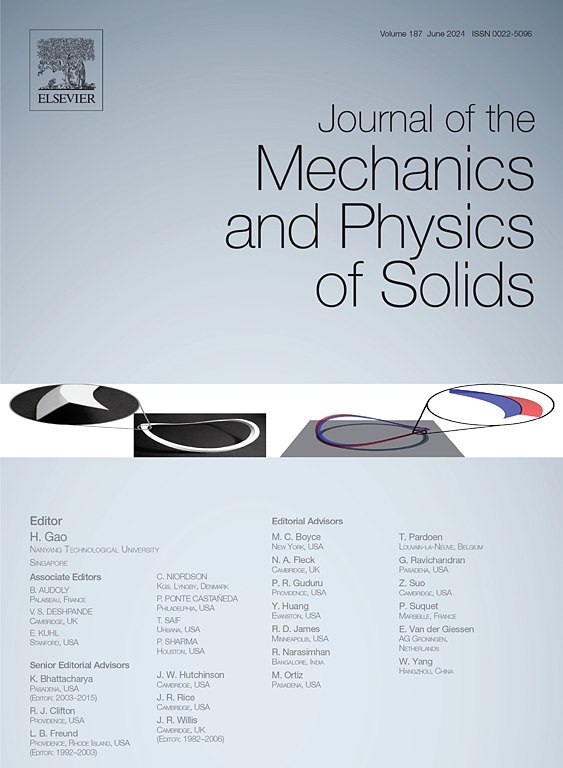考虑纠缠相关有限可扩展性的软弹性体超弹性本构模型
IF 5
2区 工程技术
Q2 MATERIALS SCIENCE, MULTIDISCIPLINARY
引用次数: 0
摘要
本文基于弯曲管的概念,建立了一种新的软弹性体超弹性本构模型。该模型统一考虑了聚合物链的有限可扩展性、缠结对弹性的贡献以及非仿射微观到宏观尺度的转变。为了反映缠结效应及其对软弹性体变形的影响,引入了扭管的概念。阐明了这种弯曲管中纠缠聚合物链的有限可拓性和构象统计。通过将弯曲管嵌入微球中,利用最小平均自由能原理,提出了一种新的非仿射尺度转换规则,建立了聚合物链在微观尺度上的局部变形与宏观尺度上的整体变形之间的关系。基于与构象统计相关的概率密度函数,建立了亥姆霍兹自由能,并进一步解耦为体积部分和等时部分。空间基尔霍夫应力张量和空间弹性张量由新建立的亥姆霍兹自由能导出。通过编写用户自定义的材料子程序,将所提出的模型进一步实现到有限元程序ABAQUS中。通过对软弹性体在单轴拉伸、单轴压缩、纯剪切、等双轴拉伸、一般双轴拉伸载荷、膨胀和压痕等不同加载模式下的均匀变形和非均匀变形进行模拟,验证了该模型的预测能力。此外,利用该模型预测并讨论了缠结浓度对软弹性体拉伸性能和刚度的影响。本文章由计算机程序翻译,如有差异,请以英文原文为准。
A hyperelastic constitutive model for soft elastomers considering the entanglement-dependent finite extensibility
In this paper, a novel hyperelastic constitutive model for soft elastomers is developed based on the concept of the tortuous tube. This model incorporates the finite extensibility of the polymer chain, the entanglement contribution to elasticity and the non-affine micro-to-macro scale transition in a unified way. To reflect the entanglement effect and its influence on the deformation of soft elastomers, the tortuous tube concept is introduced. The finite extensibility and conformational statistics of an entangled polymer chain in such a tortuous tube are clarified. By embedding the tortuous tube into the microsphere and employing the principle of minimum averaged free energy, a new non-affine scale transition rule is proposed to establish the relationship between the local deformation of a polymer chain at the microscopic scale and the overall deformation at the macroscopic scale. Based on the probability density function related to the conformational statistics, the Helmholtz free energy is established and further decoupled into a volumetric part and an isochoric part. The spatial Kirchhoff stress tensor and spatial elasticity tensor are derived from the newly established Helmholtz free energy. The proposed model is further implemented into the finite element program ABAQUS by writing a user-defined material subroutine. The prediction capability of the proposed model is verified by simulating the homogeneous and inhomogeneous deformations of soft elastomers under various loading modes, including uniaxial tension, uniaxial compression, pure shear, equi-biaxial tension, general biaxial tensile loadings, inflation and indentation. Moreover, the influence of entanglement concentration on the stretchability and stiffness of soft elastomers is predicted and discussed using the proposed model.
求助全文
通过发布文献求助,成功后即可免费获取论文全文。
去求助
来源期刊
CiteScore
9.80
自引率
9.40%
发文量
276
审稿时长
52 days
期刊介绍:
The aim of Journal of The Mechanics and Physics of Solids is to publish research of the highest quality and of lasting significance on the mechanics of solids. The scope is broad, from fundamental concepts in mechanics to the analysis of novel phenomena and applications. Solids are interpreted broadly to include both hard and soft materials as well as natural and synthetic structures. The approach can be theoretical, experimental or computational.This research activity sits within engineering science and the allied areas of applied mathematics, materials science, bio-mechanics, applied physics, and geophysics.
The Journal was founded in 1952 by Rodney Hill, who was its Editor-in-Chief until 1968. The topics of interest to the Journal evolve with developments in the subject but its basic ethos remains the same: to publish research of the highest quality relating to the mechanics of solids. Thus, emphasis is placed on the development of fundamental concepts of mechanics and novel applications of these concepts based on theoretical, experimental or computational approaches, drawing upon the various branches of engineering science and the allied areas within applied mathematics, materials science, structural engineering, applied physics, and geophysics.
The main purpose of the Journal is to foster scientific understanding of the processes of deformation and mechanical failure of all solid materials, both technological and natural, and the connections between these processes and their underlying physical mechanisms. In this sense, the content of the Journal should reflect the current state of the discipline in analysis, experimental observation, and numerical simulation. In the interest of achieving this goal, authors are encouraged to consider the significance of their contributions for the field of mechanics and the implications of their results, in addition to describing the details of their work.

 求助内容:
求助内容: 应助结果提醒方式:
应助结果提醒方式:


